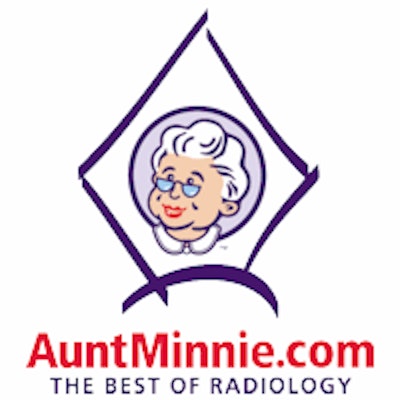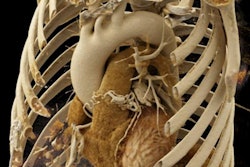
CT remains the workhorse medical imaging technology that's still making headlines some four decades after Sir Godfrey Hounsfield figured out a way to put EMI's Beatles royalties to work. This is nowhere more evident than in this year's Minnies awards, where candidates related to CT won many of the categories.
A 640-slice CT scanner got the nod as Best New Radiology Device, while the Scientific Paper of the Year describes the use of coronary CT angiography to shorten hospital stays. Radiology professionals noted for their work in CT won as Most Influential Radiology Researcher and Most Effective Radiologic Technologist Educator.
But CT also has a dark side: radiation dose. Here, too, CT's importance was demonstrated in the Minnies laureates, with a software application designed to reduce dose getting the nod as Best New Radiology Software.
Every year since 2000, AuntMinnie.com has awarded the Minnies, our annual ranking of the best of the best in radiology. Candidates are selected from nominations submitted in August by AuntMinnie.com members, and winners are chosen through two rounds of voting by our expert panelists; this year's campaign featured 205 candidates in 15 categories.
There were two new Minnies categories this year: Best Radiology Mobile App and Best Radiology Image. The latter was selected through a vote by members on AuntMinnie.com's Facebook page.
This year's winners are listed below.
Most Influential Radiology Researcher
Winner: Dr. U. Joseph Schoepf, Medical University of South Carolina
Dr. U. Joseph Schoepf's selection as Most Influential Radiology Researcher for 2013 is a recognition of the importance of his focus on the judicious use of medical imaging technology -- in particular, CT.
Schoepf received his medical degree in 1996 from Ludwig-Maximilians-University in Munich after serving several stints as a visiting medical student and rotations at U.S. institutions. After completing his residency in 2001 at the university, he moved to the U.S. for a position as staff radiologist at Brigham and Women's Hospital from 2001 to 2004.
 Dr. U. Joseph Schoepf from the Medical University of South Carolina.
Dr. U. Joseph Schoepf from the Medical University of South Carolina.
In 2004, he moved to the Medical University of South Carolina (MUSC), where he remains to this day. He is currently director of the division of cardiovascular imaging at MUSC, and he also serves as director of CT research and development at the university.
A quick search of PubMed finds Schoepf's name on several dozen research papers in just the past year, many as senior author. His main area of emphasis has been coronary CT angiography and whether the technology can be used as a replacement for more invasive catheter-based angiography. Dual-energy CT for thoracic imaging has also been another area of focus.
Schoepf hasn't been afraid to wade into the debate over CT radiation dose. He has spoken out forcefully in venues such as the International Symposium on Multidetector-Row CT on the need for radiologists to take charge of the discussion as a counterweight to some of the more hysterical articles on radiation dose that have been published in the lay press.
Such stories could be scaring patients away from receiving CT scans they urgently need, he believes. Radiologists should point out how low the cancer risk is from radiation at the dose levels typically used in imaging scans, and they should also highlight how successful radiology has been in reducing dose. Many patients urgently need information: A recent survey found that 60% believe MRI is associated with radiation, he pointed out in his MDCT talk in June 2013.
Schoepf sees his current work as an effort to make CT a "gentler" modality: "How can we scan patients with less radiation? How can we scan patients with lower volumes of contrast media?" he posed to AuntMinnie.com. "We should not be overwhelmed by the current craziness about radiation exposures. It's important to keep a level head and ensure that no one who is clinically indicated for a scan doesn't get the test that they actually need."
Runner-up: Dr. Richard Duszak, Harvey L. Neiman Health Policy Institute
Most Effective Radiology Educator
Winner: Dr. Bruce Hillman, University of Virginia
Dr. Bruce Hillman looks on his selection as Most Effective Radiology Educator with a touch of irony. "I've always considered myself a researcher first," he told AuntMinnie.com in discussing the 2013 Minnies award.
Indeed, there's no question he's been a prominent researcher. He has published more than 180 peer-reviewed journal articles and more than 140 book chapters, review articles, editorials, and texts, including the 2010 book the Sorcerer's Apprentice: How Medical Imaging Is Changing Health Care. What's more, he was the founder and currently serves as the chief scientific officer of the American College of Radiology's Image Metrix contract research organization.
 Dr. Bruce Hillman from the University of Virginia.
Dr. Bruce Hillman from the University of Virginia.
But Hillman's biggest effect on radiology has arguably come from his affiliation with the Journal of the American College of Radiology, a publication he helped found in 2003 and for which he still serves as editor in chief. When it launched 10 years ago, JACR broke the mold (at least in radiology) by focusing on socioeconomic issues rather than clinical topics, a subject that was amply addressed by a multitude of clinical radiology journals at the time.
That decision seems prescient these days, as radiologists have become preoccupied with business and productivity issues due to relentless pressure on reimbursement and the looming arrival of healthcare reform. In fact, JACR is consistently cited as one of the top two most-read journals in radiology, according to Hillman. "I think it has done much better than anyone would have reasonably thought," he said.
Hillman now splits his time primarily between Image Metrix and JACR, but he also finds time to participate in the lecture circuit, giving talks mostly on socioeconomic issues. He also maintains an appointment as professor of radiology and public health sciences at the University of Virginia (UVA), where he served as chair of the department of radiology from 1992-2003 and as president of the UVA Health Services Foundation from 1999-2003.
Runner-up: Dr. Leonard Berlin, NorthShore University HealthSystem
Most Effective Radiologic Technologist Educator
Winner: Laura Pierce, Duke University
Like many of the other winners in the 2013 Minnies awards, Pierce has long been associated with CT through her annual talks at the International Symposium on Multidetector-Row CT, where she focuses primarily on 3D advanced image postprocessing.
Pierce served as a radiologic technologist (RT) at Stanford University for 22 years, managing the growth of the lab from one site with a single employee to two sites with nine technologists, two administrators, and one database administrator. Three years ago she moved to Duke University, where she runs the 3D postprocessing lab. She's been delivering lectures at the MDCT meeting since 2001.
 Laura Pierce from Duke University.
Laura Pierce from Duke University.
Pierce said she's found that labs with technologists performing most of the postprocessing duties have more consistent 3D datasets than labs with radiologists handling the postprocessing. She now spends much of her time training technologists, as a complement to their training in image acquisition. She focuses on teaching RTs how to look at images, determine the location of pathology, and then display and measure the region of interest to enable the referring physician and radiologist to arrive at the proper diagnosis together.
Pierce sees the rise of advanced visualization as opening up a whole new career path for technologists. RTs who focus on 3D imaging learn a new range of skills, going beyond just postprocessing to comparing current studies to priors, performing quantitative analysis, and looking up patient histories. "It's not all about nice fluffy pictures anymore," she told AuntMinnie.com.
Healthcare organizations that emphasize training their RTs in new technologies such as 3D image processing are likely to have happier employees, she believes.
"I really think it's important that hospitals and organizations focus on providing a learning environment for technologists so they feel comfortable with learning new skills," Pierce said. "It's a competitive advantage for that organization because technologists have acquired new skills that are demanded by the marketplace, and therefore they are more productive and engaged in their careers and are much happier on the job."
Runner-up: Myke Kudlas, American Society of Radiologic Technologists
Most Effective Radiology Administrator/Manager
Winner: Brenda Izzi, University of California, Los Angeles (UCLA) Health
Brenda Izzi describes herself as having nursing in her blood. Growing up, "I was the little girl who bandaged 'owies'; blood didn't scare me, and I always wanted to take your temperature," she said.
How that translated into a career in radiology is a story she'll tell you with the infectious enthusiasm that seems to infuse her work. Taking nursing classes in high school, she graduated with a licensed practical nurse (LPN) credential already in hand.
 Brenda Izzi from UCLA Health.
Brenda Izzi from UCLA Health.
Her first nursing job was at the University of New Mexico (UNM), as a nurse on the floor and in the intensive care unit. She soon received a bachelor's degree from the university, as well as a registered nurse (RN) credential. Not long after, she moved into nursing management and administration.
It wasn't long before radiology caught her eye. "I saw radiology as the perfect complement to bedside care," Izzi told AuntMinnie.com. "It brought the science and information in to make life-changing decisions at the source of patient care."
She soon became an assistant to the director of radiology at UNM, and she was named interim director upon his departure. In 2001, she moved to UCLA to accept an offer as chief administrative officer of the university medical center's radiology department, a position she holds to this day.
Izzi is responsible for technology and professional issues in the department, including hospital licensing, outpatient imaging, and research and education issues. She said that she and her team run the department as a business, with no dividing lines between the hospital and the radiology group practice. The ultimate goal is always the improvement of patient care.
"We look at it as a global mission to enhance patient care, and I am fortunate to be a part of it," she said. "I really do love my job."
Runner-up: Carlos Vasquez, Franciscan St. Elizabeth Health




















